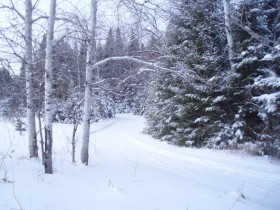COLLINS LEARNING CENTER
IS OPEN
TRAIL CONDITONS: ICY!!!
While skiers are yearning for a snowy winter, Master Gardeners are still dreaming of spring. On Tuesday, January 17 we will welcome UW-Extension Agriculture Agent Annie Deutsch who will present the lecture “The Unseen World of Insect Communication.” At Crossroads, we haven’t seen a lot of useful snow and come to think of it, insects have been completely unseen, and presumably, uncommunicative.
|
Part of the reason that insects are unseen in cold weather is that that millions of insects die at the end of summer. So why don’t they become extinct?
Before these millions of insects died, they mated and produced billions and billions are eggs. The parent insects may have died, but their offspring will hatch in spring and by the time our growing season gets here, insects will be ubiquitous.
More remarkable (to me, anyway) is that many insects survive winter in their juvenile or adult forms. Cool, yes? Well, it is very cool in winter and insects simply cannot remain active. One method of overwintering is migration. Monarch butterflies actually fly to Mexico, but for most of our insects, migration means moving to a protected place.
Insects burrow into the ground, crawl under rocks or into the cracks of building siding. Others cover themselves with a blanket of fallen leaves. Countless insects tunnel into stems and leaves of living plants. Cocoons and nests and foamy cases offer some insulation.
Aquatic insect migrate from the shallow to the deep parts of streams and ponds, to places below the level where ice will form. As long as they are in liquid water, aquatic insects can get by, becoming semi-dormant but they move very slowly if at all.
Most overwintering insects hibernate. We at least partially understand hibernation in mammals. Warm blooded creatures burn stored fat to keep their bodies from freezing. But insects are cold blooded, which means they the same temperature as their surroundings. So how can they survive?
When I have a question about insects, I call Annie the Extension (her specialty is entomology) or turn to one of my favorite nature writers, May R. Berenhaum. In her amusing but information-filled book Bugs in the System, she wrote, “To withstand the cold temperatures associated with winter, many insects accumulate large stores of glycerol, a chemical that not only looks a lot like polyethylene glycol but also shares its antifreeze properties.
“Thus hemolymph [the insect equivalent of blood] containing large amounts of glycerol has a much lower freezing point than does hemolymph without such additives.
“Aside from producing compounds that lower the temperature at which their bodies freeze, some insects manufacture chemicals that protect them from the damage caused by ice crystal formation inside the cells and are actually capable of freezing up to 90% solid for much of the winter and then thawing out come spring without incident.”
So once the soil is warm enough for planting, insects (many of them beneficial) will be with us. So anyone planning to garden next spring will want to attend the lecture.
On Friday, January 13, 2:00 we will show several documentaries about Door County. Folks who saw Wisconsin Public Television’s Wisconsin Hometown Stories-Door County probably wished that the program were longer. Actually, it was. Much of the footage could not be included in the one hour format. The Friday Film will be the Baileys Harbor Extra–four fascinating segments including: “Birds Park”, “Early History”, “Giving Back”, and “Mail Order Bride”. screening is free and open to the public.
|


